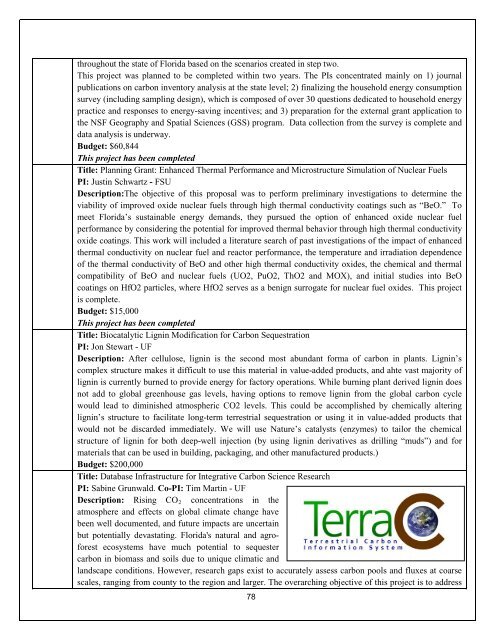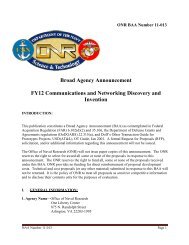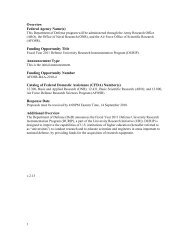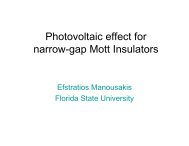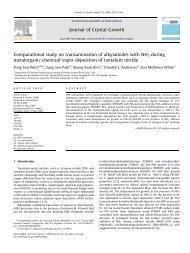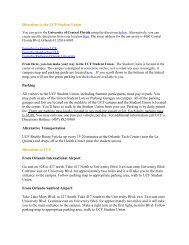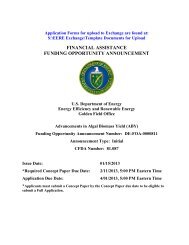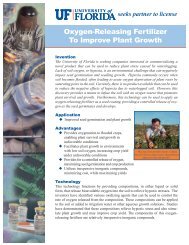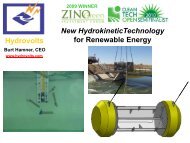Annual Report- Part III - Florida Energy Systems Consortium
Annual Report- Part III - Florida Energy Systems Consortium
Annual Report- Part III - Florida Energy Systems Consortium
Create successful ePaper yourself
Turn your PDF publications into a flip-book with our unique Google optimized e-Paper software.
throughout the state of <strong>Florida</strong> based on the scenarios created in step two.This project was planned to be completed within two years. The PIs concentrated mainly on 1) journalpublications on carbon inventory analysis at the state level; 2) finalizing the household energy consumptionsurvey (including sampling design), which is composed of over 30 questions dedicated to household energypractice and responses to energy-saving incentives; and 3) preparation for the external grant application tothe NSF Geography and Spatial Sciences (GSS) program. Data collection from the survey is complete anddata analysis is underway.Budget: $60,844This project has been completedTitle: Planning Grant: Enhanced Thermal Performance and Microstructure Simulation of Nuclear FuelsPI: Justin Schwartz - FSUDescription:The objective of this proposal was to perform preliminary investigations to determine theviability of improved oxide nuclear fuels through high thermal conductivity coatings such as “BeO.” Tomeet <strong>Florida</strong>’s sustainable energy demands, they pursued the option of enhanced oxide nuclear fuelperformance by considering the potential for improved thermal behavior through high thermal conductivityoxide coatings. This work will included a literature search of past investigations of the impact of enhancedthermal conductivity on nuclear fuel and reactor performance, the temperature and irradiation dependenceof the thermal conductivity of BeO and other high thermal conductivity oxides, the chemical and thermalcompatibility of BeO and nuclear fuels (UO2, PuO2, ThO2 and MOX), and initial studies into BeOcoatings on HfO2 particles, where HfO2 serves as a benign surrogate for nuclear fuel oxides. This projectis complete.Budget: $15,000This project has been completedTitle: Biocatalytic Lignin Modification for Carbon SequestrationPI: Jon Stewart - UFDescription: After cellulose, lignin is the second most abundant forma of carbon in plants. Lignin’scomplex structure makes it difficult to use this material in value-added products, and ahte vast majority oflignin is currently burned to provide energy for factory operations. While burning plant derived lignin doesnot add to global greenhouse gas levels, having options to remove lignin from the global carbon cyclewould lead to diminished atmospheric CO2 levels. This could be accomplished by chemically alteringlignin’s structure to facilitate long-term terrestrial sequestration or using it in value-added products thatwould not be discarded immediately. We will use Nature’s catalysts (enzymes) to tailor the chemicalstructure of lignin for both deep-well injection (by using lignin derivatives as drilling “muds”) and formaterials that can be used in building, packaging, and other manufactured products.)Budget: $200,000Title: Database Infrastructure for Integrative Carbon Science ResearchPI: Sabine Grunwald. Co-PI: Tim Martin - UFDescription: Rising CO 2 concentrations in theatmosphere and effects on global climate change havebeen well documented, and future impacts are uncertainbut potentially devastating. <strong>Florida</strong>'s natural and agroforestecosystems have much potential to sequestercarbon in biomass and soils due to unique climatic andlandscape conditions. However, research gaps exist to accurately assess carbon pools and fluxes at coarsescales, ranging from county to the region and larger. The overarching objective of this project is to address78


